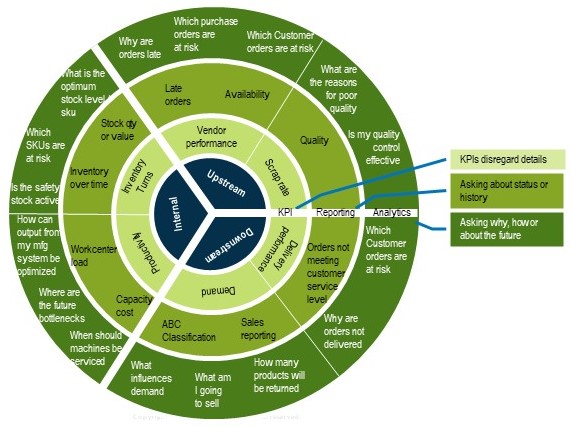I have had talks with many manufacturing, retail and energy companies this year, and the general opinion is that there is huge value to be drawn from the data that has been collected over the years. The consensus is that data can bring new insight and enable better decision making by providing a more accurate answer to the uncertainties faced.
For various reasons, people think it is difficult to start pulling value from data – or, more accurately, to start a process for systematically analysing the available data. Some data is used to calculate KPIs or shown in BI reports. The insights hidden in the data are not uncovered.
I do not want to take anything away from KPIs or traditional business intelligence. KPIs are important, as they give a quick status, and development over time is easy to follow. But by nature, they provide the overall picture and do not reveal what to do next. Business intelligence provides data at a more detailed level about what happened in the past. BI often consists of standard reports with configurable views. Typically, is not until data from multiple reports is viewed together that usable information appears. That is why traditional BI is often complemented by a series of spreadsheets giving the needed overview and answering the questions that were actually asked.
In this post I will investigate the three steps you can take to start listening to your data: 1) asking questions in another way; 2) putting together the right competencies; and 3) getting an analytics system in place.
Asking in another way
As I have argued in my earlier blog posts, the analytics process is initiated by asking questions that start with why or how – or, ideally, they should be about the future. Such questions require more advanced calculations than are used in traditional BI or calculated KPIs.
These questions can be asked on strategic, tactical and operational levels. On a strategic level, you may use analytics to optimise the locations of DCs or plants, or which countries to start new sales companies in. On the tactical level, it could be about how to optimise the product portfolio, or simply improving your forecast by adding causal factors to the model.
In the diagram below, I have listed questions that a manufacturing company could ask to supplement the KPI or BI report. I’ve split the questions so they relate to upstream, downstream or internal uncertainties.

The questions in the outer circle directly address business problems that need be solved in order to keep the business running smoothly. They are far more operational, and the answers are directly applicable and useful.
Summing up the knowledge gained from asking such questions can change KPIs from reactive to proactive. Imagine looking at your expected future delivery performance (calculated based on which future orders are likely to be delayed) instead of the historical one – which you cannot change.
Putting together the right competencies
Answering these questions requires competencies that traditionally may have been available in a manufacturing company – but only utilised sporadically. They are rarely found in one person and require the combination of different skills, mindsets and ideas to work in the best way. In my experience, a company should look to combine the following competencies:
- Subject matter expertise. Deep understanding of the area being analysed, including knowledge of process and data.
- Business understanding. The ability to ask the questions and understand the answers in a broader context and align decisions with the company strategy.
- Analytical competencies. Knowing how to deal with data and interpret results.
- Digital leadership. The ability to grow a data driven culture and lead a data driven organisation.
The first two are commonly available in all companies, as they deal with the core of the company. The third is often a scarce resource, and rarely a day goes by without a company seeking data scientists to drive its analytical processes. Lack of analytical competencies is often regarded as the bottleneck. It should, however, be possible to train employees to fill these positions. Since developing a data driven organisation is also a matter of crawling before you walk, competencies can be developed over time.
However, I see digital leadership as the most difficult competency to obtain. Ask yourself: To what extent is analytics driving the decisions made by top-level management, and to what extent does top management understand and encourage the use of analytics to support strategic or tactical decisions?
Ask the right questions, get the right competencies and #analytics system in place. Become a true data driven organisation! #DataDriven #leadership Click To TweetGet the analytics system in place
The analytics software needs to support an organisation that is continually maturing its analytical capabilities and processes. This is different from an ERP system, which largely locks the operational processes in a best-practice way of doing things.
In the above sentence, maturity relates not only to the business areas where analytics is used. Maturity also refers to the organisation’s ability to continually ask new questions. This will, in turn, influence:
- The number of users and their capabilities. Analytics may move from being done locally by a few data science experts to being done all over the organisation by people with all types of competencies.
- The variety, complexity and accuracy of the models. With more questions being asked, it will lead to a higher need for a large toolbox.
- The amount and types of data. With more questions being asked, the company needs to move from a few select data sources (e.g., an ERP system) to doing analytics on all available data, potentially including unstructured data and streaming data.
This is why scalability and diversity are keywords, alongside trust, to become successful with an analytics software package.
